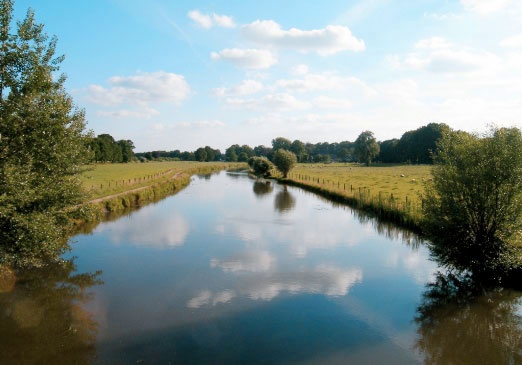

The river was first. Modest and meandering, it bears a proud name. Kromme Rijn, meaning Crooked Rhine. Braiding on its way to the sea, the river creates its own fortress of banks. Solid deposits of soil left and right are cut through by the next flood. They provide roads to be traveled, tracts to build upon.
| |
Coming from the East, Kromme Rijn fills the canals of nearby Utrecht. |
Clear upstream water and sandy soil on its north bank create ideal conditions to build country houses for local nobility in the Middle Ages. The river shapes the landscape in its first-natural-order.
A Baroque attitude creates a second order with vistas and lanes to link manmade parks with their natural surroundings.
The following intervention is in the 19th century with the Waterlinie defense works. Inundation to keep the enemy at bay would not work on these high grounds near Utrecht. Fort Rhijnauwen is ready in 1869 but never sees action. Yet it defines the landscape with a third-military-order.

Plan
With time, structures and functions change. Form follows. Nature is subject to constant fluctuations of growth, bloom and inevitable decay. The jungle looms. To counter decline, a plan with vision is needed. A forward looking view, inspired by the area’s past, guarantees its future.
Woodland
Dense patches of forest on the higher grounds above the meandering river are valuable historical reminders. Their natural urge to grow should be respectfully neglected.
Meadow and orchard
Agriculture provides food for the city nearby. Cattle and fruit prosper in the open spaces. This man-made part of the landscape needs articulation. Grazing and trimming are the tools.
Park
Solitary trees connect density and openness. Trees that have walked out of the forest give shelter and mark the seasons by changing color and shedding leaves. Where the river is not directly visible in the flatness of the country, curving rows of willow trees signal its course from afar.
Avenues
The monumental houses enjoy vistas, emphasized by tree-lined lanes. Geometry is the ultimate addition to nature, making it a human habitat.
Client
Municipality of Utrecht
Credits
Simon Klingen
Klingen Bomen
Erik van der Staak
Staro/Bos en
Natuurbeheer